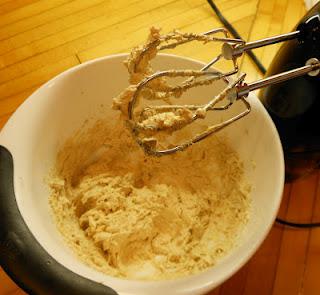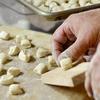To cream butter properly, the butter should be room temperature. Do not over soften or melt the butter or it will be oily and it will not “cream” correctly. Creaming of butter can be done with a wooden spoon, a handheld beater or a stand beater. Butter is usually creamed with sugar first because it has fine granules that cut through the butter and add air, creating little bubbles. These air bubbles help cakes to rise and maintain a light texture. The more air pockets you start with, the more loft you will get from the batter, regardless of the amount of baking powder or baking soda you add. Once heated, the air in the pockets expands, helping the dough/batter to rise.
 Begin by beating the butter on low speed briefly and add in the sugar and continue beating on low speed to combine. When the sugar is evenly distributed, increase speed to medium and continue beating. When the granulated sugar is first added, the texture of the butter will look sandy but after a minute or two the sugar seems to dissolve into the butter. The color of butter will start to pale. Stop the beater occasionally and use a spatula to scrape the sides of the mixing bowl to incorporate any stray sugar and butter. Finally, when butter is properly creamed, the color will be off-white, the texture is thick and creamy and the volume will have increased noticeably. At this point, do not continue to cream the butter or it may soften and all efforts will be wasted.
Begin by beating the butter on low speed briefly and add in the sugar and continue beating on low speed to combine. When the sugar is evenly distributed, increase speed to medium and continue beating. When the granulated sugar is first added, the texture of the butter will look sandy but after a minute or two the sugar seems to dissolve into the butter. The color of butter will start to pale. Stop the beater occasionally and use a spatula to scrape the sides of the mixing bowl to incorporate any stray sugar and butter. Finally, when butter is properly creamed, the color will be off-white, the texture is thick and creamy and the volume will have increased noticeably. At this point, do not continue to cream the butter or it may soften and all efforts will be wasted.If liquids are added too quickly, the creamed mix will curdle and separate. For this reason, add one egg and mix in slowly followed by 1 tablespoon of flour. Continue adding all the eggs (and alternately a tablespoon of flour) and beat well. The eggs will allow even more air to be whipped in (think meringue here).
Next, add the dry ingredients alternately with wet ingredients like water or milk. When adding the dry and liquid ingredients, it is important to mix as little as possible while getting the ingredients combined. The less you mix, the less gluten is developed, resulting in a tenderer final product. Adding flour before adding the liquid helps to coat the flour with fat, further inhibiting gluten production. If you add liquid first, and then add flour, you will end up with a chewier final product since more gluten will be activated. The batter can get very thick, as in cookie dough, or fluffy like cake batter. Rarely does the creaming method produce a batter that is truly wet and pourable.
Once all ingredients are combined, bake according to recipe instructions. You should be able to see the difference in a well-made batter in the final product.

